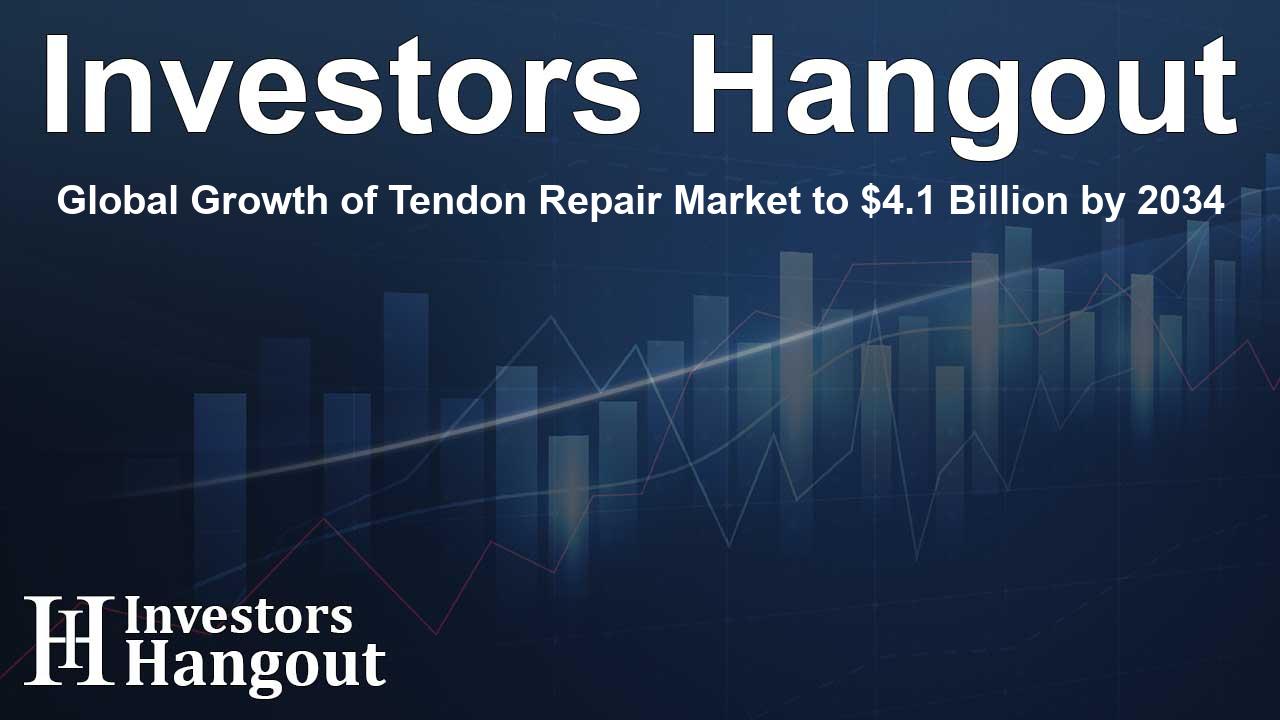Global Growth of Tendon Repair Market to $4.1 Billion by 2034

Understanding the Tendon Repair Market
Tendon repair is a crucial surgical procedure designed to restore the function and strength of damaged tendons, which can result from injury or overuse. During this procedure, surgeons reattach or stitch together the torn ends of a tendon, enabling patients to regain their mobility over time. Recovering from tendon repair often involves immobilization followed by a comprehensive physical therapy regimen, particularly for injuries in areas like the hand, shoulder, and major joints.
Market Growth Insights
The tendon repair market has been gaining traction, with numerous reports suggesting significant growth potential. The market, valued at approximately $2.4 billion in recent assessments, is projected to achieve a remarkable valuation of $4.1 billion by the end of its forecast period in 2034, driven by a compound annual growth rate (CAGR) of 5.8%. This expansion can largely be attributed to the increasing incidences of sports injuries and the rising geriatric population, both of which contribute to a higher prevalence of tendon-related ailments.
Market Drivers and Trends
A surge in tendon injuries, particularly among sports enthusiasts and the aging population, has been evident. For instance, sports-related injuries represent a considerable segment of the tendon repair market, with statistics indicating millions of reported cases annually. Additionally, advancements in non-invasive surgical techniques and biologic therapies, such as platelet-rich plasma (PRP) treatments, are enhancing patient recovery outcomes. Companies are taking advantage of innovations to create faster and more effective healing options for patients.
Emerging Technologies in Tendon Repair
As technology progresses, the tendon repair sector has seen the introduction of bioengineered grafts and regenerative medicine solutions that offer enhanced healing capabilities. Notable advancements include the development of bioactive or decellularized grafts, which have shown significant promise in improving tendon repair success rates, particularly in challenging cases. Furthermore, the focus on minimally invasive surgery allows for reduced recovery times and fewer complications, making treatment more appealing to patients.
Segment Analysis
The tendon repair market is segmented into various categories, including product type, application, end-user, and geographic regions. By product type, the market includes devices like suture anchors, grafts, and screws. Applications are categorized into several types of tendon repairs, such as rotator cuff and flexor tendon repairs. End-users primarily consist of hospitals, clinics, and surgical centers, with hospitals retaining a significant market share.
Regional Market Perspectives
North America currently dominates the tendon repair market, attributed to its advanced healthcare infrastructure and high demand for orthopedic surgeries. The region has witnessed a steady rise in sports-related tendon injuries among its population. Europe also represents a robust market, driven by its emphasis on clinical research and an aging demographic that increases the demand for tendon repair procedures. Meanwhile, the Asia-Pacific region is rapidly expanding, with rising healthcare investments and increasing awareness about orthopedic treatments.
Strategic Initiatives and Competitive Landscape
Players in the tendon repair market are engaging in strategic initiatives such as acquisitions, product launches, and collaborations to expand their market presence. Companies are leveraging innovative technologies and increasing research and development (R&D) investments to stay competitive. A notable case is the agreement by a major player to acquire a promising startup focused on soft tissue healing technologies, further demonstrating the shift towards advanced treatment options.
Frequently Asked Questions
What is the tendon repair market?
The tendon repair market encompasses surgical and non-surgical treatments to restore tendon functionality after injury or degeneration.
Why is the tendon repair market growing?
The growth is driven primarily by rising sports-related injuries and an increasing aging population more susceptible to tendon damage.
What factors are influencing the advancements in tendon repair?
Key factors include technological innovations in surgical techniques and the introduction of regenerative therapies facilitating better healing.
Which regions are leading in tendon repair procedures?
North America is currently the leading region, followed by Europe and the Asia-Pacific area, due to varying demographic and healthcare investments.
What are the challenges faced by the tendon repair market?
Challenges include high surgery costs and a shortage of skilled orthopedic specialists in certain regions, potentially limiting treatment access.
About The Author
Contact Ryan Hughes privately here. Or send an email with ATTN: Ryan Hughes as the subject to contact@investorshangout.com.
About Investors Hangout
Investors Hangout is a leading online stock forum for financial discussion and learning, offering a wide range of free tools and resources. It draws in traders of all levels, who exchange market knowledge, investigate trading tactics, and keep an eye on industry developments in real time. Featuring financial articles, stock message boards, quotes, charts, company profiles, and live news updates. Through cooperative learning and a wealth of informational resources, it helps users from novices creating their first portfolios to experts honing their techniques. Join Investors Hangout today: https://investorshangout.com/
The content of this article is based on factual, publicly available information and does not represent legal, financial, or investment advice. Investors Hangout does not offer financial advice, and the author is not a licensed financial advisor. Consult a qualified advisor before making any financial or investment decisions based on this article. This article should not be considered advice to purchase, sell, or hold any securities or other investments. If any of the material provided here is inaccurate, please contact us for corrections.
